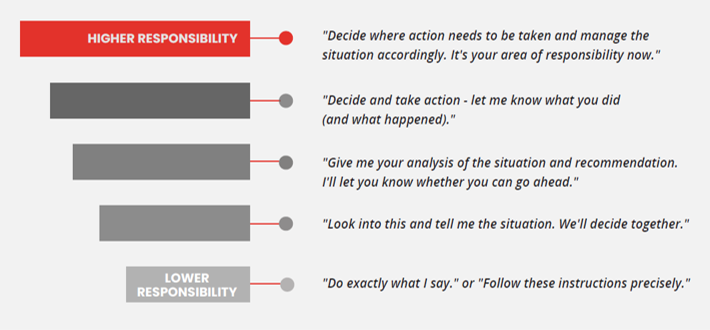How to Delegate More Effectively

Want a better business? Learn how to delegate effectively.
On a scale of one to five, where would you currently rate your delegation skills?
Do you need to be the final approval step of every piece of business from day to day?
Or are you as hands off as they come, entrusting responsible team members to make sure that the wheels keep turning smoothly?
I’d be willing to bet that you fall closer to the first option than the second.
No matter what your reasons for hanging on are, I can assure you that proper delegation will keep your business running as efficiently as possible.
Many business owners get stuck in a hub-and-spoke model of management where every task and decision must come through them.
I often describe this as being the only air traffic controller in the airport.
You feel like you’re being pulled in 100 different directions and if you so much as stop to use the washroom, the planes start crashing.
If you want to take your business to the next level – you need to get good at delegating.
I first learned how to delegate when I was 22 or 23 years old – working as a store manager for men’s clothing retailer.
Watch the video to hear me tell the story – or scroll down to read.
Early in my career, I was a store manager at Tip Top.
We had maybe five full time employees and a bunch of part timers.
It was my job to delegate work to them.
So, here’s what I did.
I assigned a section of the store to each of the full timers.
This meant that one person would be in charge of the suit section, another would be in charge of sportscoats and pants, and someone else would be in charge of haberdashery – dress shirts and ties.
Then I met with them each Monday and asked “What do you need from me? What’s going on in the suit department? We have a sale going on this week – what help do you need from me and the other team members to get the suit department ready for the sale?”
I put them in charge. They take responsibility for their job. I make myself available to provide accountability and help them succeed.
This is what it means to delegate.
Where delegation goes wrong: micromanagement or abdication
In my 20+ years of coaching, I’ve noticed that a lot of business owners don’t really understand what it means to delegate.
They either micromanage by telling their people exactly what to do and how to do it.
Which often leads to a feeling of “it would just be easier to do it all myself!”
Or they abdicate by providing no direction or guidance at all.
This often leads to “No one can do anything properly.” Or “I can’t find good employees.”
Delegation isn’t about dumping authority.
It’s about assigning the appropriate level of responsibility.
Determining the right level of delegation

The right level of delegation varies based on the employee’s skill level and the context of the situation
There are degrees of delegation.
At the lowest level, it looks like “Wait to be told. Do exactly what I say or follow these instructions precisely.”
When you go up a couple notches it might sound like: “Look into this. Tell me about the situation and we’ll decide together.” This was the level I mostly used in my Tip Top days.
Above that, it could be: “Let me know your decision, then wait for my go-ahead before proceeding.” If the suit department guy had been on the job for 2 years, we might be at this level of responsibility.
At the highest level, it’s: “Decide where action needs to be taken and manage accordingly. It’s your area of responsibility now.” Without proper training and coaching, this is abdication.
The right level of delegation depends on the context.
 Someone might be a “level 9” in a role they’re highly experienced in – but only a “level 3” when you move them somewhere else.
Someone might be a “level 9” in a role they’re highly experienced in – but only a “level 3” when you move them somewhere else.
You can involve people in determining their level of delegation by showing them a chart and asking: “Where do you think you are on this scale?”
From there, you can have a mutual understanding.
The next step is to clarify your expectations by asking your employee to create an SOP (standard operating procedure) for the task you just assigned.
(I outlined how I do this with my VA in this article: how to onboard your VA.)
This meets several goals:
- You are certain that your employee knows how to do what you’ve assigned
- You can use it as a teaching tool
- You have the steps documented for future use – you can give it to someone new and they can follow the steps
Have you ever wondered how McDonald’s can get their French fries to taste the same in any location? When those fried are cooked by a 16-year-old whose parents can’t get them to clean their room?
It’s through SOPs! There’s a system and process that you can teach.
Delegation is one of the most important skills a business owner can learn because it gives you leverage
Delegation gives you leverage.
Leverage through delegation is about getting more done with less of your personal intervention.
How can you get the same outcome as you could produce yourself, but through the efforts of others?
Most business owners have never learned how to do it – so they end up as hub-and-spoke managers.
If you’d like some help learning this critical leadership skill, consider delegating your training to a business coach. 😉
I can help you speed up the process and avoid common pitfalls.
To discuss coaching, book 15 minutes on my calendar here: Book a call with John

Build a Self-Managing Company
How to build a business that runs smoothly, profitably, and (mostly) without you.
Feeling stressed out and overwhelmed with a business that is taking all your time - and not giving you enough in return?
Are you finding it challenging to hire the right team (and get them to do the right things)?
I wrote this little guide for you!
Enter your details below to receive your free copy!
